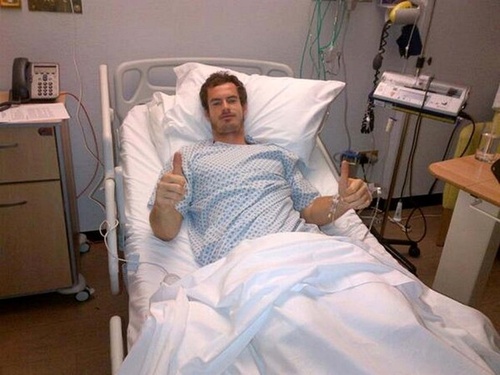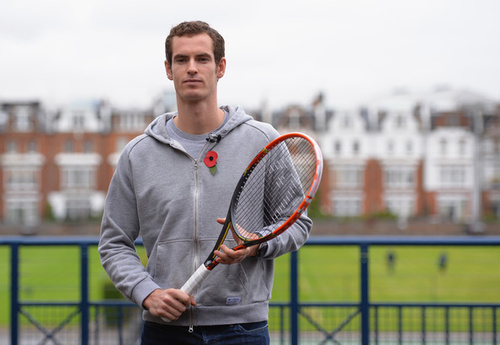Don't miss any stories → Follow Tennis View
FollowResuming Play: Thoughts on Andy Murray's Looming Return
The 2014 season is little more than a scant five weeks away, and if there is one player who is potentially more eager than his peers to get the ball rolling in a new year, it is Andy Murray. We last saw the Scot in early September when he helped the British Davis Cup Team earn a World Group berth before minor back surgery forced him to bring his 2013 campaign to a premature end.

The good news for Murray and his fans is that recovery seems to be coming along nicely. Earlier this week, he posted a picture of himself practicing on the Crandon Park Stadium Court, the site of the Miami Masters 1000 tournament. Although he has wisely insisted that he will come back only when completely fit, Murray has listed upcoming exhibitions in Barbados and Abu Dhabi as well as the January 2014 Doha tournament on his slate. Thus, things look positive for his return to tennis to come sooner rather than later.
Irrespective of whether it does come sooner rather than later, Murray’s anticipated return is good for the game and could turn into one of the intriguing plot points to chart as the year progresses. Will he quickly resume his status as one of the heavy favorites at most of the events that he enters? Might he post the kind of awe-inducing results we saw from Nadal this past season? Or might he struggle and find himself pushed back a peg or two? There is no clear answer yet because there are many factors to consider.
Murray has several factors working in his favor, starting most significantly with the fact that, after undergoing back surgery, he should feel confident about swinging away even more freely. His hiatus from the game has not been nearly as lengthy as Nadal’s absence, but, like the Spaniard, Murray should return feeling hungrier and more physically and mentally refreshed than many of his fellow competitors. He also has the comfort of knowing that he has historically proven himself a step above the majority of his competition. Plus, assuming that he can begin his 2014 campaign in Doha, he will have the luxury of starting his comeback at the start of the season. During that time, many other players will be working through the inevitable butterflies that come with the dawn of a new tennis year and their own return to the courts.
For all of the positives pointing to a successful comeback for Murray, however, he also will have to overcome some hurdles. For example, Murray is unlikely to win few, if any, sets or games in the locker room. He does not yet possess the same aura of invincibility that someone like Nadal or Novak Djokovic does because he has spent much of his career as a junior member of the ATP Big Four. The Scot was consistently a higher caliber player than the majority of the field, and yet he always seemed a step or two behind the likes of Roger Federer, Nadal, and Djokovic. Murray did much to close the gap with those three by winning the 2012 London Olympics and US Open as well as Wimbledon this past year, but he still exhibits more vulnerability than either Nadal or Djokovic at this stage in the game.
Another challenge for Murray is that he does not really have a safe surface in which he can be guaranteed to pick up tournament wins. When Nadal came back, there was the sense that even on two bad knees and one arm tied behind his back, he could waltz away with the trophy at any clay-court event. This is not the case with Murray on any surface. In general, Djokovic is a better hard-court player, Murray can be picked off by a clay-court specialist on the dirt, and he has not quite done enough on the grass to acquire the reputation that Federer earned for his exploits on that surface.

On the other hand, Murray typically has been one of the best performers at the start of a season. He has won Brisbane two years running and reached the semifinals or better of the Australian Open in each of the last four years. That said, there is no real feeling that he is a guaranteed lock to continue the trend when 2014 gets underway.
An important, external part of the reason why Murray might not be considered a lock to quickly resume his place near the top is that some of the members from the rest of the field have been steadily improving. Particularly in the autumn, Juan Martin Del Potro took a few more steps towards recapturing the 2009 US Open form that could see him stake a claim within the top three. Tomas Berdych continues to post big wins, and Stanislas Wawrinka is playing the best tennis of his career.
Players like these could pose problems for Murray early in his comeback, and indeed, they already did before his injury. In 2013 alone, Del Potro bested Murray in Indian Wells, Berdych clipped him in Madrid and Cincinnati, and Wawrinka handed him losses in Monte Carlo and the US Open. If these three and others can bring their best form, they have shown a greater ability to upset Murray than Nadal or Djokovic.
Finally, while Murray competes against his peers in an effort to gain supremacy, he will likely still continue to occasionally do battle with another familiar foe: himself. Since taking on Ivan Lendl has a coach, the Scot has improved the mental aspect of his game in leaps and bounds. The evidence lies in the way that he bounces back from tough defeats in a much quicker and more professional manner than before. But there is no denying that he is still quick to get down on himself in the midst of a match. Murray shows far more negativity than the other members of the Big Four, and it still proves a potential stumbling block. The Scot is a perfectionist, and any rust resulting from the extended layoff could leave him a little more than annoyed. If the emotional outbursts come, do not be surprised if opponents not named Nadal or Djokovic find a way to take advantage.
During his comeback, Murray needs to focus on controlling what lies within his hands. if he can do that, the odds strongly favor him resuming his place at the top of the game. Should he fail to do so, however, then rising challengers like Del Potro and Wawrinka might be ready to step up and overtake him. No matter which way the wind blows, it should be entertaining to see what unfolds in 2014 when Andy Murray makes his return to tennis.










